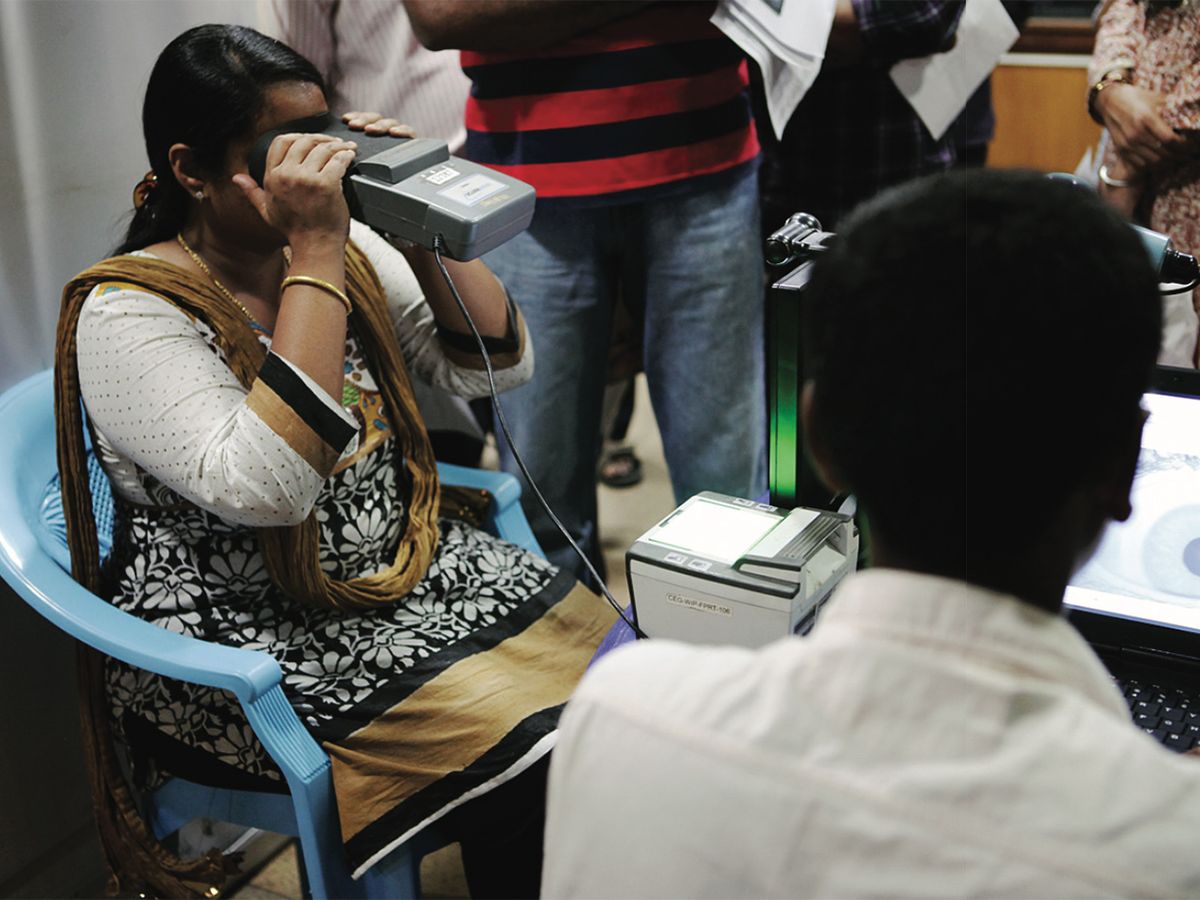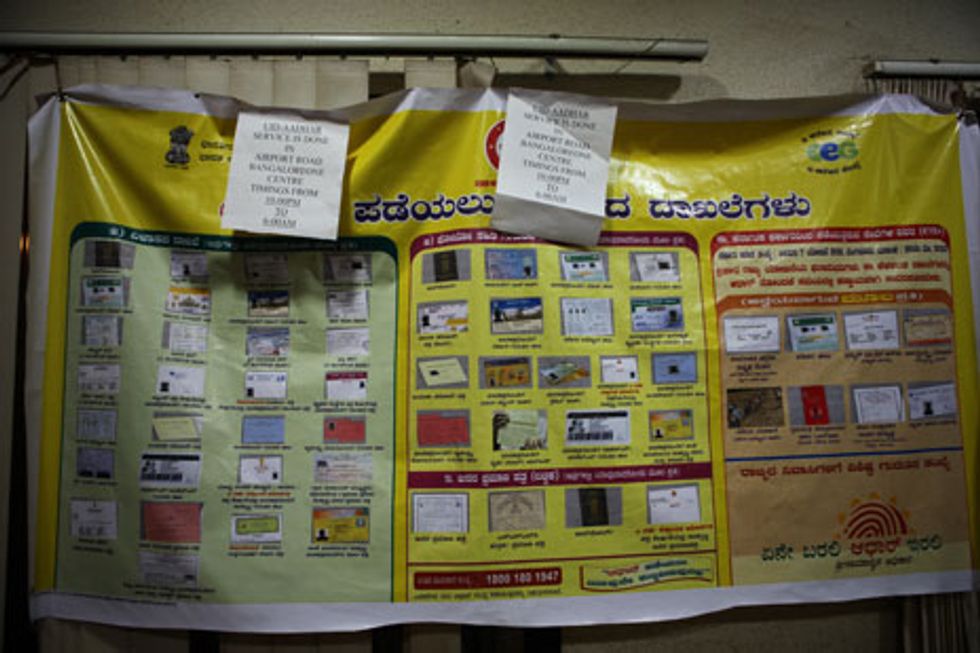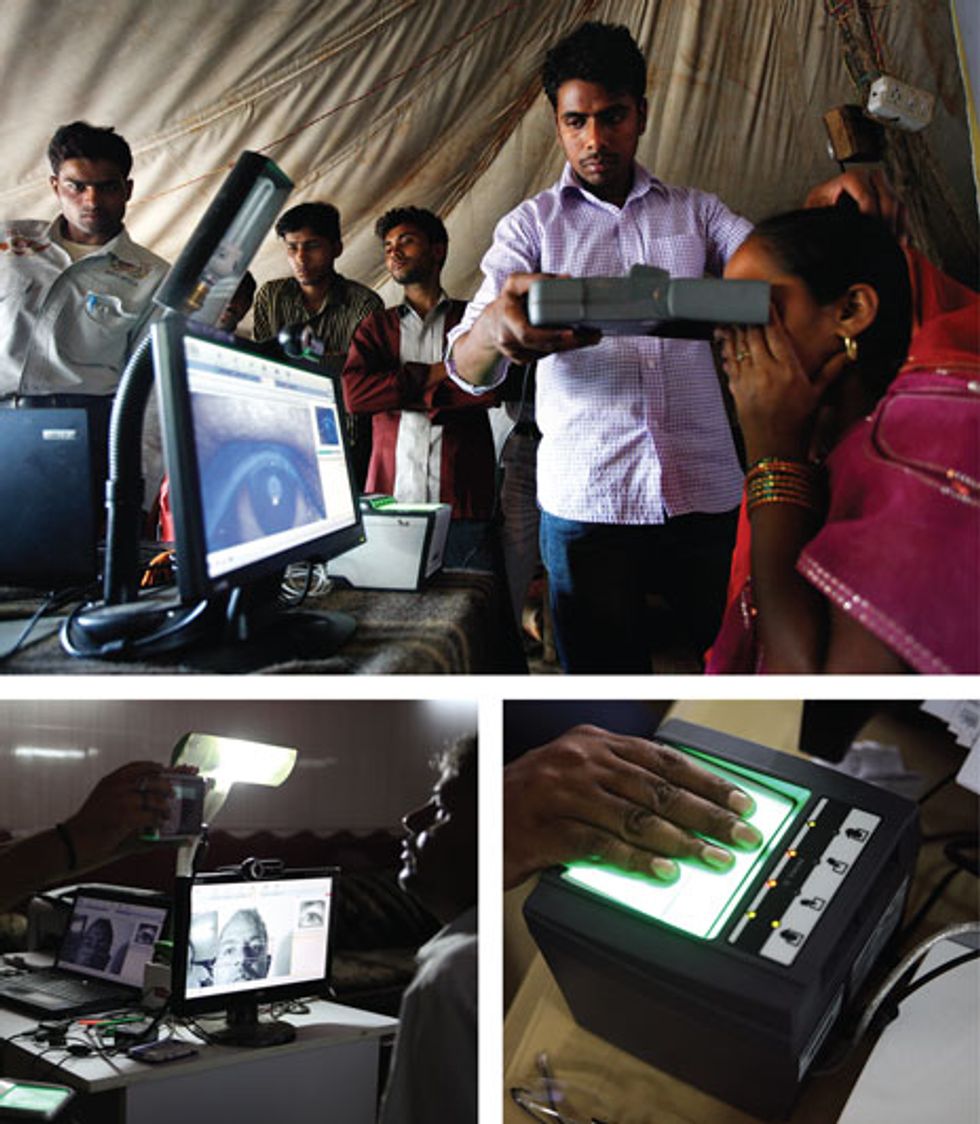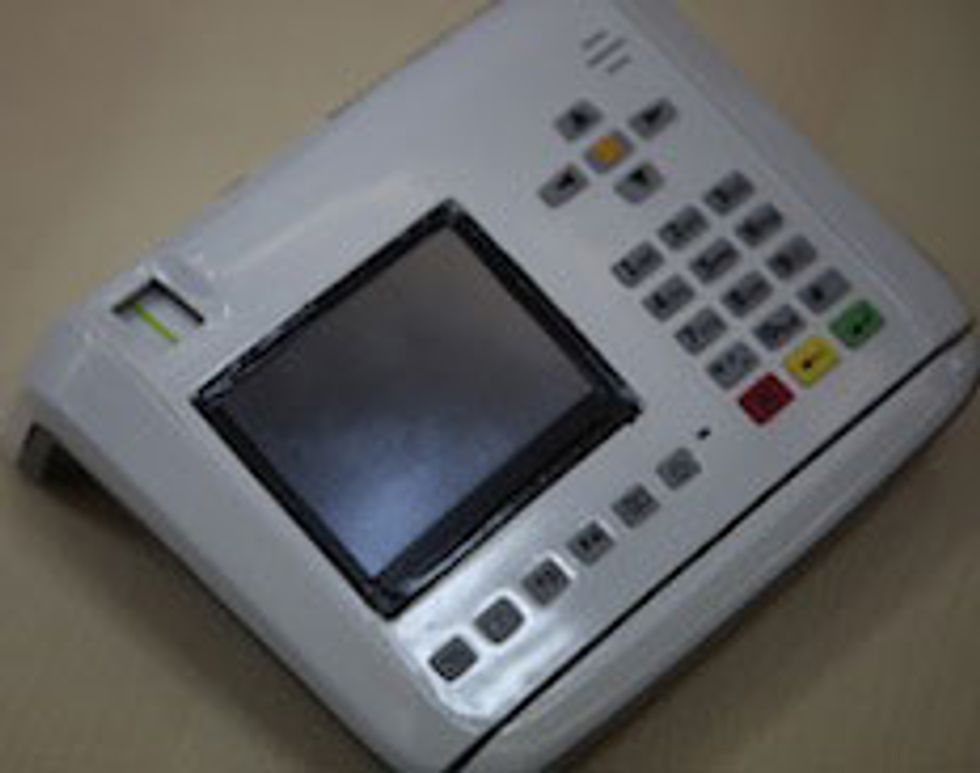India’s Big Bet on Identity
The world’s largest biometric authentication system reaches its first major milestone, but lots of challenges remain

Driving around Bangalore, it’s immediately clear that the infrastructure hasn’t kept up with the IT boom in this once-sleepy South Indian city. Auto rickshaws, scooters, and motorcycles squeeze into a tight phalanx at each red light and choke the air with exhaust. Construction, such as the concrete supports of the new metro rail line that looms overhead, causes detours everywhere, and in spots the entire road abruptly disintegrates into gravel.
But something miraculous happens as you make your way south, past the outer ring road. A ramp lifts a select few vehicles out of the weaving traffic and onto an elevated tollway, where you suddenly have a bird’s-eye view of the urban landscape. This is the road to Electronic City, an oasis of glass and steel high-rises overlooking pristine black asphalt paths that snake through the perfectly manicured lawns of tech companies like Wipro, IBM, and Infosys Technologies.
“If you can have such good roads in the Infosys campus, why are the roads outside so terrible?” That’s the common question foreign visitors would ask Nandan Nilekani, one of the company’s cofounders. “Politics” was his usual reply, according to Nilekani’s 2008 book, Imagining India. Now the man who has been called the Bill Gates of India has jumped into politics to try to use what he learned at the IT giant to transform the dysfunctional country that lies beyond the borders of Electronic City.
Since July 2009, Nilekani has been a cabinet minister, leading hundreds of engineers and entrepreneurs as chairman of the Unique Identification Authority of India (UIDAI). By the most conservative estimates, at least a third of the country’s 1.2 billion citizens live below the poverty line and outside the formal economy. The UIDAI is expected to connect those hundreds of millions of people to government programs, save public money, reduce fraud and corruption, and foster new business opportunities—all by creating an unprecedented biometric system.
“On the one hand, within India and across the world, people of Indian descent have done some remarkable work,” says Nilekani. “And on the other hand, here is a country that needs to solve some very basic problems. This project marries these two worlds.” UIDAI plans to use fingerprints and iris scans to assign every person in the country a unique 12-digit ID number that can be verified online. It’s one of the biggest IT projects in the world, and getting bigger: By early February, the UIDAI had issued 130 million ID numbers, and it can issue up to a million more IDs every day. The agency has set up 36 000 enrollment stations staffed by 87 000 certified enrollment operators. In India the project is called Aadhaar, which means “foundation” or “support,” because it’s meant to be a fundamental technology platform that will enable dozens of new public and private services to be created.
That’s if it all works. It’s easy to list major challenges: How exactly do you collect biometrics from every single person in the world’s second most populous country, especially those living at the margins? How do you keep bad data from getting into the database in a country rife with corruption? And how can you build the entire system around online authentication in a country where fewer than one in 20 people have access to the Internet?
The answers to these questions are getting more than the usual amount of scrutiny, because a lot of political fortunes are riding on the UIDAI.
The program has been heavily supported by the ruling Indian National Congress party; Nilekani was appointed by the prime minister himself, Manmohan Singh. But Singh and his Congress party have had a difficult time enacting many of their biggest policy goals, and the UIDAI has increasingly become the target of criticism.
Earlier this year, the whole scheme seemed in imminent danger of collapse, when a parliamentary committee killed the bill that would have given the program statutory authority, and a political turf war erupted between the UIDAI and the National Population Register, another government project collecting biometrics for the national census. But by late January the two sides had reached an agreement to share biometric data collection, and Aadhaar is once again moving full steam ahead with a new mandate and an estimated budget this year of 15 billion rupees [PDF] (about US $300 million).
To understand why the government has invested so heavily, it helps to know the current state of affairs in India. Aadhaar is meant to provide a form of identification that’s free, national, impossible to counterfeit—and available to everyone. “There’s an ID divide,” Nilekani explains, between people who have multiple official IDs and the hundreds of millions who have none. Only about 60 million people in India have passports, he says, and only about 100 million have photo ID bank cards. The most prevalent document is a voter ID card, which has been issued to about 700 million people, covering just over half of the country. But these and the rest of the official IDs created by the country’s vast bureaucracy all have shortcomings.
The primary reason for creating a biometric ID system is to give India’s poorest citizens better access to an array of welfare programs. India spends about 2 percent of its gross domestic product on social programs like the Public Distribution System, which provides subsidized rice, wheat, and other staples, and a rural employment scheme that guarantees 100 days of work. But all such programs suffer from severe “leakage”: According to the World Bank, corrupt officials and middlemen siphon away 59 percent of the money before it reaches the intended recipients. Eventually, the government hopes to provide funds directly to each person who needs them.
Most states issue ration cards, but they usually aren’t valid in other states. An official ID that can be used throughout the country is increasingly important as more and more people move away from their hometowns to follow employment, Nilekani says.
Complicating the problem further, existing ID cards are easy to duplicate. Some states have more names on their food ration lists than there are people living in the state. To fight counterfeiting, the Aadhaar team decided to use biometrics instead of issuing just another ID card. From the beginning, they consulted biometric experts, used existing standards when they could, and studied similar systems like the U.S. Visitor and Immigrant Status Indicator Technology program, run by the U.S. Department of Homeland Security.
One thing the team realized early on is that a single biometric measurement wasn’t enough to guarantee uniqueness. In proof-of-concept studies, researchers determined that only by using all 10 fingerprints and a scan of both irises could error rates be kept manageable. Adding iris scans also makes the program more inclusive for people whose fingerprints have been worn down by manual labor.
Getting an Aadhaar number is not a quick process. One Friday after midnight, I watch dozens of families wait patiently in a municipal building where only half the lights are on and there’s always a baby crying. While Anurodh Kanchan waits, he explains that he came at this hour because he’d heard the lines were even longer during the day. He’d already been once before to schedule this appointment. Now his 7-year-old daughter dozes on his wife’s shoulder as the whole family waits another half an hour for the enrollment agent to return from a break.
Hiring and training people to work as agents has been one of the project’s biggest logistical challenges. The UIDAI outsources enrollment to “registrars”—often state governments or banks—which in turn hire accredited agencies to actually set up and staff the centers. The agencies get paid a flat rate for each successful enrollment, as do the agents they hire. A coordinator for one of the largest agencies told me that his organization had significantly overestimated how many enrollments an agent could complete in a day. UIDAI says that an average station (see photos, “Necessary Gear”) can process each enrollment in under 10 minutes, but in the days I spent observing, it wasn’t uncommon for the process to take twice as long. And if you’re an agent looking at a line of people stretching out the door, it’s easy to see how you might begin to rush through your tasks.
That’s why enforcing quality is left to a piece of software known as the enrollment client, installed on each agent’s laptop. The program manages every step of the process and was developed jointly by engineers at UIDAI and MindTree, an Indian IT company. Because enrollment often takes place in remote locations with no Internet access, the client must be fully independent and be able to run off a single laptop. The developers also had to make sure that the enrollment client could work seamlessly with any of the 11 biometric devices from various manufacturers that had been certified for use. And the initial version had to be built fast: MindTree won the contract at the end of April 2010, and the UIDAI wanted to enroll the first resident by that August.
MindTree met the deadline, and the client it designed now manages to prevent and correct most errors an enrollment agent might make. In addition to a simple quality check, the software looks for self-consistency—for instance, verifying that each fingerprint isn’t coming from the operator or another recently enrolled resident and that all 10 fingerprints and two irises are distinct from each other. If something goes wrong in a biometric capture, the software tells the operator how to correct it—for instance, it can distinguish between a facial photo that’s too dark and one in which the person was photographed at the wrong angle.
Still, over the last 21 months, the software engineers have had to continually improve the program to address new challenges encountered in the field. For example, when the UIDAI began enrolling people in the Punjab region of North India, where many men wear long beards and large turbans, enrollment agents had a hard time taking a photo that the software considered acceptable: The turban would be interpreted as an unacceptable background, or the automatic cropping feature would crop around the turban instead of the face. The software team was able to quickly tweak the parameters and release a new version of the client so that enrollment could continue.
It isn’t just the biometric collection that’s tricky. A resident must also supply basic demographic data—name, age, gender, and address. Residents can fill out paper forms in any of the 16 official Indian languages, which agents must first transfer to the computer and then translate into an English version of the form. This is by far the most time-consuming part of the process, and MindTree has tried to speed it up by building transliteration into the client software. But Indic languages have many variations—some are written right to left, and many use unique character sets. Still, the agent is expected to check the results and clean up minor mistakes.
There are obviously both privacy and security concerns when you’re collecting personal data from more than a billion people. “You can’t change your biometrics,” points out Sunil Abraham, the executive director at the Center for Internet and Society, in Bangalore, so if they become compromised, it’s a difficult problem to fix.
Among the precautions the UIDAI takes is to encrypt all data as soon as they’re collected. The data can be decrypted only by UIDAI servers, so the records aren’t even accessible to the operator or enrollment agency that collected them. At the end of each day, all the encrypted enrollment data are stored on USB flash drives, and the drives are transported to a place with Internet access so the data can be uploaded to UIDAI’s servers. It’s in the best interests of the enrollment agencies to safeguard the data, because otherwise they won’t get paid.
From the enrollment centers the action moves to the racks of servers at the UIDAI Central Information Data Repository, which is also in Bangalore. Here is where deduplication—checking each new enrollment against every other record in the database—will arguably make this identity scheme rise above the rest. Ensuring that no person can get two numbers is key to making biometrics a worthwhile investment. A few years ago, one Indian state collected biometrics for everyone below the poverty line, but it didn’t have the technology or a plan to prevent duplicates. It ended up capturing 1.2 times the population, which resulted in a significant leakage of benefits.
Many critics, including members of Parliament, have doubted that it’s even possible to deduplicate records from the entire Indian populace. It’s certainly a big task. In order to issue 1 million Aadhaar numbers in a single day, the current maximum rate, the data center must conduct 100 trillion person matches. To improve this process, the UIDAI came up with an unusual arrangement. Rather than hiring a single firm for the job, it awarded the project to three contractors, each responsible for processing a portion of the enrollments, with the overlapping records used to compare performance between the systems. This arrangement lets the UIDAI know if a system isn’t working correctly and also gives the companies a financial incentive to improve their software—they’ll get to process more records, and get paid more, if their products perform better. The vendors were even required to use the same kind of hardware to build their systems, so the agency isn’t tied to any one company.
In late January, the UIDAI released a report [PDF] that for the first time detailed the results of this deduplication effort. There are two primary factors that determine the accuracy of a biometric system: the false-positive rate, which in this case is how often a newly registered person is incorrectly judged to be already enrolled, and the false-negative rate, which is how often true duplicates are not recognized as such. To measure the false-positive rate, the UIDAI tested 4 million unique records against a subset of the enrollment database containing 84 million records: Of the unique records, 2309 were falsely rejected, for a false-positive rate of 0.057 percent. The agency also tested 31 399 known duplicates. The system caught all but 11, for a false-negative rate of 0.035 percent.
The false-positive rate applies to the total number of records in the database. As that number grows, the rate should increase in a linear fashion, because there are more opportunities for false matches. The false-negative rate, on the other hand, applies only to the small minority of enrollments that really are true duplicates (the UIDAI estimates that these make up only 0.5 percent of all incoming enrollments). Because the false-negative rate doesn’t depend on the total number of records, it should remain steady unless more people try to enroll multiple times.
R.S. Sharma, the director general of UIDAI, says that preventing all duplicates with technology alone is impossible. There are some people who just can’t be uniquely identified through biometrics, because the data for them aren’t good enough—children under age 5, for instance, and people with multiple disabilities. That’s why the responsibility for accuracy and uniqueness isn’t all left up to the software. Several full-time employees manually review the roughly 0.2 percent of cases that the software can’t handle, resolving errors and looking for evidence of fraud.
Even if the system isn’t perfect, it’s likely to be much better than any existing alternative, simply because it will eliminate “ghost identities,” says M.R. Madhavan, who works at the Centre for Policy Research, in New Delhi. “At least people who died in 1995 or 2005 will not get into the system,” he says.
Now that the UIDAI has shown it can collect biometric and demographic data and eliminate duplicate enrollments, much of the attention will shift to the authentication system, where people can prove their identity with just the swipe of a finger. Such systems are still under development, so most residents I met weren’t clear about the benefits of the program. When I asked people why they were enrolling, they often had vague reasons: “It might make it easier to get my benefits,” said one middle-aged woman in Bangalore. “I heard you’ll need it to buy heating gas,” said another woman. “I think it’s mandatory,” an elderly man told me. Nilekani thinks that getting authentication services up and running will be the best way to demonstrate the power of the entire project.
Here’s how such a futuristic system might work: Walking up to a wirelessly connected terminal at a local shop, a person will type in his name and Aadhaar number, and then he’ll scan his fingerprints. The data will be sent to a central database, where the Aadhaar number will be used to locate his record. The submitted name and biometric data will be compared to those on file, and the software will determine whether they match.
The UIDAI imagines that such biometric terminals will eventually be ubiquitous. The first devices deployed will likely be micro-ATMs in rural shops. These machines process transactions electronically, just like a full-size ATM, except they don’t store and dispense cash—that gets handled from the shopkeeper’s till. The hope is that such systems will deliver financial services to the 40 percent of the Indian population who have never had bank accounts. When people enroll for Aadhaar, they simply need to check a box and an Aadhaar-enabled bank account will be created for them.
In January, the UIDAI began a pilot project in the state of Jharkhand, where workers in the rural employment program could collect cash payments by scanning their fingerprints at a micro-ATM. Another pilot program in Maharashtra transferred small amounts of money to individual Aadhaar numbers, showing that bank servers could be easily linked with the UIDAI system.
The authentication system is already available as an application programming interface (API), which means it won’t be limited to just government programs and banks. Private service providers could use it to verify new customers as well. Take India’s vaunted mobile-phone culture: Phone companies are currently required to collect and retain significant documentation for every person they sell a SIM card to, as I found out in the two days I spent collecting the photos and local references I needed to get one myself. “If you look at any service provider, they’re not going to offer the mobile-phone service unless they verify who you are,” says Bala Parthasarathy, an entrepreneur who worked in Silicon Valley but came back to India to volunteer on the project for a year. Parthasarathy says that using Aadhaar for identity verification could provide the telephone companies with major savings.
Still, setting up a nationwide network of biometric terminals has plenty of its own challenges. First, India will need better connectivity. Wireless voice networks now cover most of the country, but wireless data networks have trailed behind. Current penetration of 3G is mostly just in the cities, says Debabrata Das, an IEEE member and a professor of electrical engineering at the International Institute of Information Technology, Bangalore, who has been studying the network challenges of authentication as a technical advisor for the state of Karnataka.
The API will also need to be flexible enough to handle variations in the demographic data that are submitted. The system can’t enforce strict matches: Many Indians use initials in their names, and there is no guarantee that they will always spell their names the same way in English. Further, sometimes a married woman will use her father’s family name instead of her husband’s. Because of the ambiguity in names and addresses, the database must be able to perform partial and fuzzy matches. Eventually, Sharma says, the UIDAI hopes to be able to do database matching for all the Indian languages as well, so the API will continue to undergo revisions.
Now the UIDAI must wait for its partners to begin taking advantage of the system, and Nilekani admits that starting up such services is largely beyond his control. Cooperation with other agencies and industries is all part of Nilekani’s approach to how government initiatives should work. “The big thing to my mind has been, How do you create a model of change, and how do you carry a lot of people with it? How do you think this through in a way that everyone comes on board?” he says. In building the project to this point, he’s managed to bring, if not everyone, then certainly a pretty diverse crowd: technical experts; national, state, and local officials; banks and businesses; and all those millions who willingly wait in line for hours.
“Everyone puts their own aspirations on it…like Obama,” he jokes. But the downside of being so inclusive is that as the project matures, it may be difficult to keep all the interested parties happy, and there’s bound to be disappointment if the project fails to achieve all its lofty ambitions.
The project has made it this far by adapting quickly as problems arise. “Think of it as multigeneration, continuous improvement,” Nilekani says. “You launch and get feedback and you get criticism. You need to build a rapid feedback loop, which is what we’ve built.”


